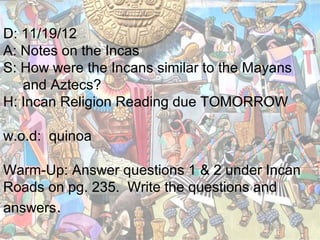
How the Incas were organized and what they grew
- 1. D: 11/19/12 A: Notes on the Incas S: How were the Incans similar to the Mayans and Aztecs? H: Incan Religion Reading due TOMORROW w.o.d: quinoa Warm-Up: Answer questions 1 & 2 under Incan Roads on pg. 235. Write the questions and answers.
- 2. Word of the Day WORD DEIFINTION SENTENCE PICTURE Quinoa was Domesticated A native plant so it could be quinoa to the Andean grown for region that food by the Renders Incans. nutritious seeds
- 3. I. History a. There is no written history of the Incas. All we know is from Spanish writings and artifacts b. Ruled from 1438 to 1471 in the Andes mountains of Peru, Chile, Bolivia & Argentina c. They were conquered by the Spanish
- 4. II. Religion a. They worshiped many gods & goddesses b. The creator was the God of nature named Viracocha c. The sun god was named Inti and they used gold to represent him i. The Incas believed that Inti made the first Incan Manco Capac who went into the wilderness and built the first Incan city of Cuzco ii. The sun god became the father of all Incan rulers
- 5. II. Religion a. Incas believed that you could figure out what the gods and goddess wanted by divining. To do this you had to find magic signs by studying objects b. They also worshiped huacas or sacred things like mummies & temples c. They had daily religious ceremonies d. Monthly ritual ceremonies were held that included dancing, feasts, games, songs & parades e. The Incas did animal and human sacrifices but only sacrificed children
- 6. III. Agriculture a. Incas grew potatoes, corn, tomatoes, avocadoes, peppers, strawberries, peanuts, cashews, squash, beans, pineapples, & chocolate b. The potato was the most important food to the Incans called papa c. They had over 40 varieties of potatoes and would freeze dry there to last for years. They made the first potato chips d. Corn was also important and they grew over 20 varieties called sara e. In order to grow in the mountains the Incans used terrace farming to allow them to create farmland in tiers. f. Men & women worked together to farm g. They dug trenches & tunnels to get water to the crops and cities
- 7. IV. Arts & Crafts a. Weaving was the most important & well known craft i. Cloth was made of cotton alpaca, llama & vicuna fur & dyed to make many colors ii. They created looms to weave their cloth iii. The chosen women live in the temples to weave the rulers clothing that was only worn once then destroyed b. They used silver, gold, copper & bronze to make metal objects and decorate clothes, buildings and pottery c. Anyone who worked had to pay a work tax and part of their finished products went to the government d. All gold become automatic property of the rulers
- 8. V. Roads & Bridges a. The Incas built the best transportation systems. b. Over 12,000 miles of roads were built for pedestrians they did not use the wheel to move objects or people. c. Roads were built as part of the labor tax to the government d. All roads belong to the government and were only used with permission e. They built causeways or hanging bridges to get over water or had pontoon bridges that floated on top of the water f. The last bridge was a basket that hung on rope and moved by a pulley system.
- 9. VI. Government a. Inca was the name of Incan ruler b. The ruler was a descendant of the gods c. The ruler had many wives but the main one was the gueen d. The ruler also had many children and the council picked the most promising one to become Inca e. A borla or crown was worn by the ruler
- 10. VI. Government f. They only ate and drank off things made of gold g. Servants carried the Inca on a platform he never walked far h. Each new ruler had a new temple built i. There was a 30 day mourning period when the Inca died j. The priests and generals all became nobles and ruled the commoners k. The government oversaw all work
- 11. VII. Major Cities a. The Incas were the best builders of Ancient Latin America b. The cities were planned in grids c. The center of the city had a plaza with the temple priest and nobles’ houses then commoners around that d. Close to the cities the Incas built stone fortress in case of danger e. All the buildings were made of stone and shaped to fit like a puzzle so no cement was used to hold them in place. f. The two most famous Incan cities are Cuzco & Macchu Picchu
- 12. VIII. The Llama a. The llama was the most important animal to Incas b. It was used to carry goods, water & people c. It gave the Incans clothing for warmth, rope, sacks & wool d. They used the meat to make jerky